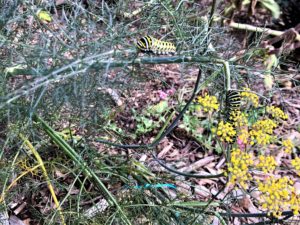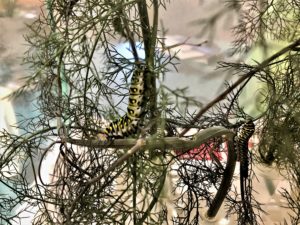It is October 22nd and we are at the Pollinator Preserve to host our final Pop-up Explainer Station for the season. Sharing this space and its inhabitants with our visitors is a highlight for us, as we get to talk about the worlds of plants, insects, gardening, biodiversity, and more! We watch the interactions between the plants and insects while we discuss pollinator gardens and the important roles they fill, not just for our enjoyment, but for the environment as a whole.
I meander to gain perspective on the subtle changes, noticing more plants setting seed that the birds may enjoy. Other late-season flowers are beginning to open. Though there is still a richness of color, there is less insect activity and we know it won’t be long until the first frost reaches us. I am always keeping an eye peeled for insects, for the fascinating treat of watching them forage, rest, or clean themselves. It is always worth a moment of my time.
I pass the bronze fennel and see a black swallowtail caterpillar. My heart sinks as it is so late in the season. Dipping down into the 40s at night, it is beginning to feel chilly. Upon closer inspection, I find six more small to medium-sized. While swallowtails spend the winter in their chrysalis and can withstand the freezing temperatures in that stage of their metamorphosis, caterpillars can freeze to death. These seven caterpillars will have a rough road ahead of them. The fennel will die from a frost, even if the caterpillars survive a bit longer. I move on as our visitors are strolling in. They will enjoy seeing these caterpillars along with the various flowers, seed pods, and the cocoons and chrysalides we have to share. The occasional butterflies and many bees sipping nectar will add to their excitement.
Over the next ten days, I check on these seven caterpillars often. They are slow to grow due to the cold, but they remain on the fennel through the wind and the rain, seemingly motionless. I know they have changed their positions and have molted to the next instar (stage of growth), with two now in their fifth and final instar. I check the forecast and see the first frost is expected in two days. Do I leave them to nature’s frost? Do I rescue them? I know the answer. I have known it all along.
I return on Tuesday, November 2nd, knowing the first frost is coming within hours. Our army of horticulture volunteers will lead the removal of the netting over the Butterfly House tomorrow, and there are tasks to accomplish as we prepare for this change. It’s cloudy and cool on this Election Day, and there’s no school for many children. We have quite a few young visitors as we tend to the garden, and they are fascinated by these seven beauties: “How cute!,” “Can I touch one?,” “Aren’t they cold?” Some tell me they’ve seen these same caterpillars at home but didn’t know what they were. We finish our work, but I stay back and begin to collect bronze fennel from various plants in the preserve. I then cut back the fennel where the caterpillars are, snipping long fronds without harming the caterpillars on the stems.
It takes awhile for me to exit as the families I pass are curious. I spread the message for these seven, how this plant is the key to their survival and how much we depend on insects. I answer their questions as they share their stories about the caterpillars and butterflies they’ve seen this past summer. They are delighted at having had the chance to see them up close.
At home, I place the fennel and caterpillars in one of my butterfly habitats. I’ll keep them outside unless the temperatures get too low overnight. They will be exposed to natural light and darkness and I’ll replenish the fennel and keep their habitat clean. It may take a few weeks for the last one to form a chrysalis, but these seven lives are significant and worth this small effort. The hard part is keeping them cold and safe as I wait for spring’s warmth to signal their emergence.
This story will outwardly end when I take these seven back to Tyler to release them in the spring — I’ll be sharing their journey of flight with those who happen to be at the Pollinator Preserve that day. As those children and adults reach in to allow a butterfly to crawl on their hands to be released, I know they will remember that moment for a very long time. But the story does not truly ever end, as there are now more people to share the message these seven caterpillars have brought to us — a message of the importance of life and caring for this land with greater purpose as we face challenges in the environment we haven’t yet experienced.
If I am lucky, some of the visitors who saw me collect these seven caterpillars will return on a day I, too, am at the Pollinator Preserve. They will recall their previous visit, but they will be most excited to share what they’ve seen and learned since our chance encounter in Fall of 2021. And I will be eager to watch their faces and hear everything they have to say.









